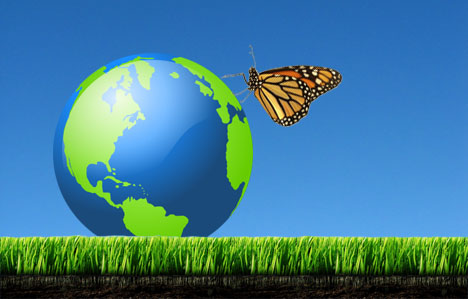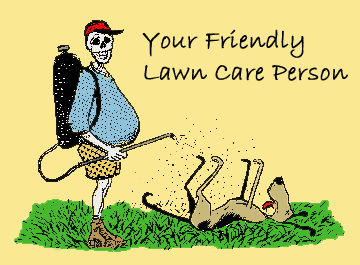May 2014
 Here it is April and spring again. We are all pleased to see an end to winter and get outside. The drawback to spring is that you need to keep your lawn looking as nice as your neighbors. Using dangerous chemicals can be avoided with some simple steps. These environmentally friendly tips will make your yard safe for your children and pets while improving its appearance.
Here it is April and spring again. We are all pleased to see an end to winter and get outside. The drawback to spring is that you need to keep your lawn looking as nice as your neighbors. Using dangerous chemicals can be avoided with some simple steps. These environmentally friendly tips will make your yard safe for your children and pets while improving its appearance.
Initially you will want to look carefully at your lawn. Does it have too many weeds? What kind of weeds are they? Where are they located? Is excess thatch a problem? Are your bare spots out in the sun or in the shade? These clues will help you deal with your weeds.
One of the first steps you can take is to have the soil in your yard tested for PH levels. You can contact Kull Scape in East Peoria for testing. If your yard is too acid you will be told to apply some lime. If it is not acidic enough you will need to add sulfur. These can be purchased at lawn and garden centers like Kull Scape.
The second major step in improving many lawns is to have it aerated. If you are a do it yourself type you can rent an aerator at most tool rental stores. You can also hire many lawn care services to do this for you. An aerator looks like a big lawnmower. You will walk behind the aerator as it moves across your yard. It will punch and pullout plugs, pieces of soil that look like short fingers. You can rake these up, or leave them on the yard to be washed away in the next couple of rains. You need to aerate when the grass is actively growing and before you spread fertilizer on the yard. So this is a good time to do this. The aeration helps to break up soil that is too compacted, make it easier for natural decomposition and worms to build up the soil. It also will help reduce the amount of thatch in the lawn. Some thatch is good, because it shades the grass, the rainwater, and keeps windblown dust out of the air. When you are done with these steps you will need to choose the correct grass seed for your lawn. You will want to use a full sun or a shade mix where appropriate.
Your next step is adding some type of fertilizer to the lawn. This is the step where you skip the dangerous chemicals and use some mix of natural materials that will not endanger your children or pets when they are playing in the grass. Milorganite is a good choice. It is a very slow nitrogen releasing compound with non leaching phosphorous. There are also some ways to control any weeds you have, but a good way to start is to strengthen and thicken your grass first. Wherever weeds are a major problem you might mix 1 tsp dish soap, like Dawn, with ¼ cup of salt and ½ gallon of apple cider vinegar. Spray this solution on weeds only. The soap strips the weed of its protective oils allowing the vinegar and salt to kill it.

The final general step to achieve a nice lawn without dangerous chemicals is mowing and watering the grass. Set the mower high so it cuts only the top 1/3 of the grass. Use the mulch setting and leave the clippings on the lawn. This will shade the soil and keep it from drying out. The clippings will add nutrients to the lawn. You will need to mow a little more often, but your yard will be healthier and look better because of it.
Now you can deal with some specific weeds that still have a foothold in your yard. Crabgrass and goose grass following a hot dry summer can be kept from sprouting by applying corn gluten meal, an organic pre-emergent weed killer. Apply this in the spring and the fall when you fertilize.
One of the weeds you might want to eliminate from your yard is clover. Clover grows better than grass in poorly fertilized lawns. So having your soil tested and adding the correct amount of slow release fertilizer and adjusting the lime or sulfur will help with this problem. Crabgrass is another troublesome weed. It can be controlled by mowing high and spreading corn gluten meal, which is an organic pre-emergent weed controller. Next in shady areas weeds such as creeping Charley and violets can get a start and then move into the rest of the yard. Again it will help to mow high. You should also use only one to two pounds of nitrogen per year. You might also reseed that area with a more shade tolerant grass that can compete with these weeds.
The most difficult weed to control organically is the dandelion. You will need to pull what you can by hand. This is easiest when the plant is young and the soil is wet. After you pull the weed pour Natural Horticulture Vinegar into the hole to kill the tap root. This is stronger than regular vinegar so don’t get it on anything else. When you are reasonably dandelion free put down the pre-emergent corn gluten.
The last move you might take to keep your yard well maintained and help the environment is to consider the type of mower you are using. You might want to switch to a reel mower. You push them and the blades cut the grass. There is no motor. An electric mower achieves the same goal. There are many models out there that are run by battery so you don’t have to worry about cutting the cord as you mow. The air polluting particulate matter and gases produced by an hour of running a gas powered mower are much worse than driving your car for the same amount of time. Also, there will be no noise to bother the children or your neighbors.
Good luck with keeping your lawn clean, green, and safe for your children and pets, even if you have just spread fertilizer or sprayed for weeds.
- Bob Jorgensen of East Peoria Green with advice from Gretchen of Kull Scape of East Peoria